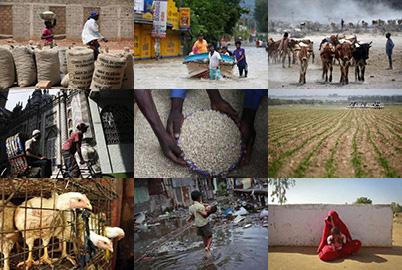Women who make goods like clothing and street food in slum homes are producing less amid baking temperatures and floods, hurting their fragile livelihoods, a survey finds
By Anuradha Nagaraj
CHENNAI, India, Jan 20 (Thomson Reuters Foundation) - Rising heat and heavier rains across South Asia, as the planet warms, are forcing home-based women workers to cut down on hours as their houses get hotter or are flooded often, resulting in a loss of income they cannot afford, researchers said on Thursday.
In a survey of 202 women in cities across India, Nepal and Bangladesh, more than 40% said they were spending less time on their informal jobs and earning less, found HomeNet South Asia, a regional network of groups representing home-based workers.
Across South Asia, women home workers make up nearly a quarter of total female employment, as against only 6% for men, HomeNet said in a report, adding "home (based) work is one of the most vulnerable and lowest-paid types of work".
Higher summer temperatures have directly impacted afternoon productivity, with some women reporting a 30% drop in what they make, from food to clothing, according to the report.
"Living in a semi-pucca house (hut) with a tin roof, it becomes so hot inside that working in the afternoon is very difficult in summer," said Goma Darji, a garment worker from Nepal who was cited in the report.
"If I use the fan, the electricity bill goes up, which I can't afford," she added.
Mamtaben, an Indian street-food vendor, has also seen her income shrink as heat and unseasonal rains reduce the length of time she can hawk her wares.
"Because the weather is so hot, all the food prepared gets spoilt and wasted if we don't sell it the same day," Mamtaben was quoted as saying in the report, which examined the impact of climate change on home-based workers.
"In addition, nowadays, there is rainfall at any time of the year and any time of the day. When it rains, people don't come out to have street food ... when we don't meet our expected sales, we have to bear the loss," she said.
The women - who largely live in urban slums - can ill afford this dip in production and income, with daily earnings for most already below the international poverty threshold of $1.90 per person per day, the report noted.
It also flagged growing hours of unpaid care-work that have led to a dip in paid work, with increasing cases of heat-stroke and water-borne diseases affecting families.
In the past decade, South Asia has seen more frequent and extreme weather - from droughts and floods to heatwaves and hailstorms - with two-thirds of HomeNet survey respondents believing these were "acts of God".
Amid a lack of awareness and measures to help them deal with climate change impacts, most of these "invisible" women workers are using negative coping strategies, including moving home or giving up their livelihoods, the report noted.
Lead researcher Dharmistha Chauhan told the Thomson Reuters Foundation such women are part of global supply chains and there is an urgent need for companies to start investing in them.
"They need support for re-skilling and help to become climate-resilient," she said.
"Most assume there is nothing they can do to combat climate change, which they identify by the increase in the number of heavy rain days or prolonged high temperatures."
The report proposes using heat-resistant building materials and energy-efficient household appliances, and improving access to drinking water, as well as offering social security and financial assistance to upgrade homes.
Read more:
Climate migration predicted to rise in India as extreme weather worsens
Flood-prone Mumbai digs in to tackle warming-worsened 'monsoon mayhem'
Unequal risk: How climate change hurts India's poor most
(Reporting by Anuradha Nagaraj @AnuraNagaraj; Editing by Megan Rowling. Please credit the Thomson Reuters Foundation, the charitable arm of Thomson Reuters, that covers the lives of people around the world who struggle to live freely or fairly. Visit http://news.trust.org)
Our Standards: The Thomson Reuters Trust Principles.

